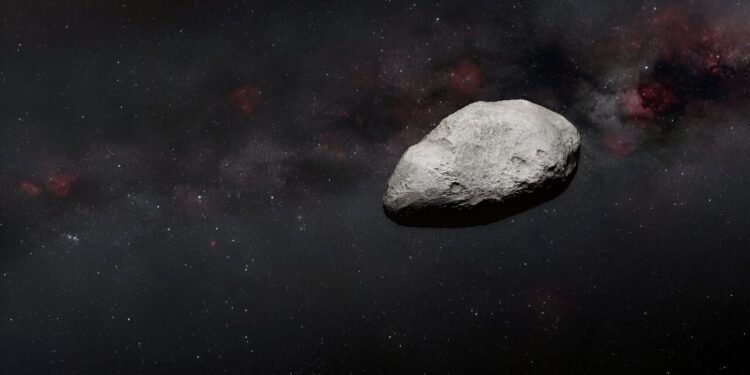A large asteroid could threaten life on Earth – but nuclear bombs could come to the rescue, a new lab experiment suggests.
Humanity could use a nuclear bomb to deflect a massive and potentially deadly asteroid hurtling toward Earth in the future, according to scientists who tested the theory in the lab by beaming X-rays at a marble-sized “dummy asteroid.”
The biggest real-world test of our planetary defenses came in 2022, when NASA’s refrigerator-sized DART spacecraft crashed into a 160-meter-wide asteroid, knocking it off course.
But for larger asteroids, simply smashing them with spacecraft probably won’t be enough.
When the Chicxulub asteroid, about 10 kilometers wide, struck the Yucatan Peninsula about 66 million years ago, it is believed to have plunged the Earth into darkness, caused tsunamis several kilometers high and killed three-quarters of all life, including the extinction of the dinosaurs.
We humans hope to avoid a similar fate.
There is currently no imminent threat, but scientists are working on how to ward off large asteroids that might occur in the future.
One leading theory is to blow them up with a nuclear bomb, a last-minute plan depicted in the 1998 sci-fi action film “Armageddon.”
In the film, Bruce Willis and a courageous team of drillers save Earth from an asteroid 1,000 kilometers wide, about the size of Texas.
For a proof-of-concept study published in the journal Physics of nature This week, a team of American scientists worked on a much smaller scale, targeting a dummy asteroid just 12 millimeters (half an inch) wide.
Asteroid Dimorphos streaks across the sky after being struck by NASA’s DART spacecraft, which altered its trajectory.
To test whether the theory worked, they used what was billed as the world’s largest X-ray machine at Sandia National Laboratories in Albuquerque, New Mexico.
The machine is capable of generating “the world’s brightest X-ray flash using 80 trillion watts of electricity,” Sandia’s Nathan Moore, lead author of the study, told AFP.
Much of the energy created by a nuclear explosion comes in the form of X-rays. Since there is no air in space, there would be no shock wave or fireball.
But X-rays still have a powerful effect.
Transformed into a “rocket engine”
For the lab experiment, X-rays easily vaporized the surface of the dummy asteroid.
The vaporized material then propelled the dummy asteroid in the opposite direction, so that it effectively “turned into a rocket engine,” Moore said.
It reached speeds of 250 kilometres per hour, “about as fast as a high-speed train,” he added.
The test marked the first time that predictions about how X-rays would affect an asteroid were confirmed, Moore said.
An artist’s illustration showing the DART spacecraft heading toward the asteroid it will impact.
“It really proves that this concept could work.”
The scientists used modeling to extend their experiment, estimating that X-rays from a nuclear explosion could deflect an asteroid up to four kilometers wide, if given enough advance warning.
Larger asteroids are the easiest to detect in advance, so “this approach could be quite viable” even for asteroids the size of Chicxulub, the dinosaur-killing asteroid, Moore said.
The experiment involved using a one-megaton nuclear weapon. The largest nuclear bomb ever used was the Soviet 50-megaton Tsar Bomba.
If a planet-saving mission were to take place in the future, the nuclear bomb would have to be placed within a few miles of the asteroid — and millions of miles from Earth, Moore said.
Asteroids come in many forms
Testing this theory using a real nuclear weapon would be dangerous, extremely expensive and prohibited by international treaties.
But there is still much to be discovered before a high-risk test can be carried out.
The biggest uncertainty right now is that asteroids can “come in many forms,” Moore said.
The asteroid Bennu, from which a NASA spacecraft collected samples and returned them to Earth.
“We must be prepared for all scenarios.”
For example, the asteroid hit by DART, Dimorphos, turned out to be a pile of poorly assembled rubble.
The European Space Agency’s Hera mission is set to launch next month with the aim of learning more about its composition and the finer details of how DART sent it packing.
Mary Burkey, a scientist at Lawrence Livermore National Laboratory in California who was not involved in the new study, has run computer simulations of using nuclear weapons on asteroids.
She praised the study, saying that “being able to match my calculations to real data increases the credibility of my results.”
His simulations also demonstrated that such a mission “would be a very effective way to defend planet Earth,” Burkey told AFP.
“However, for this to work, there needs to be enough time after a mission for the extra burst of velocity to shift the asteroid’s trajectory away from Earth.”
More information:
Nathan Moore, Simulation of asteroid deflection with a megajoule-class X-ray pulse, Physics of nature (2024). DOI: 10.1038/s41567-024-02633-7. www.nature.com/articles/s41567-024-02633-7
© 2024 AFP
Quote: Lab experiment suggests destroying massive asteroid could save Earth (2024, September 25) retrieved September 25, 2024 from
This document is subject to copyright. Apart from any fair dealing for the purpose of private study or research, no part may be reproduced without written permission. The content is provided for informational purposes only.



